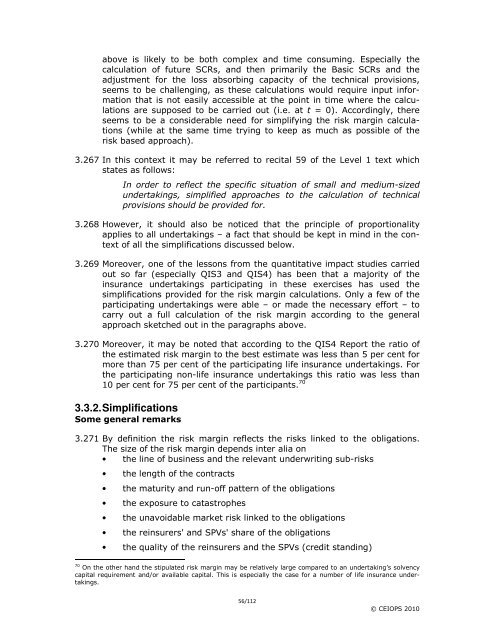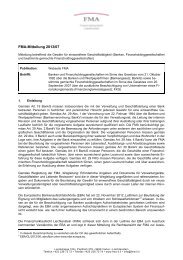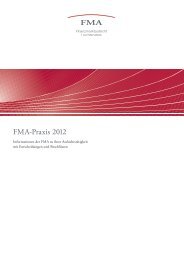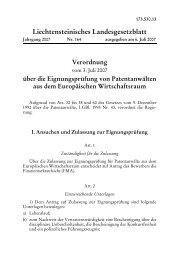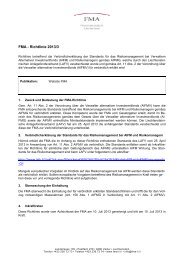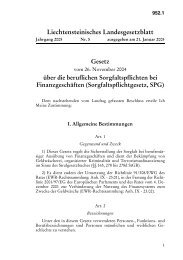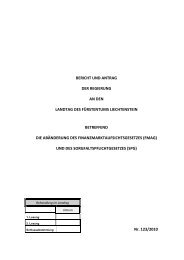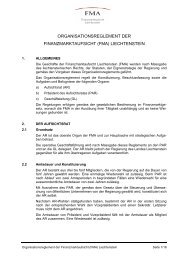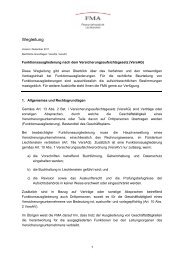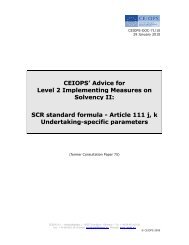CEIOPS' Advice for Level 2 Implementing ... - EIOPA - Europa
CEIOPS' Advice for Level 2 Implementing ... - EIOPA - Europa
CEIOPS' Advice for Level 2 Implementing ... - EIOPA - Europa
Create successful ePaper yourself
Turn your PDF publications into a flip-book with our unique Google optimized e-Paper software.
above is likely to be both complex and time consuming. Especially the<br />
calculation of future SCRs, and then primarily the Basic SCRs and the<br />
adjustment <strong>for</strong> the loss absorbing capacity of the technical provisions,<br />
seems to be challenging, as these calculations would require input in<strong>for</strong>mation<br />
that is not easily accessible at the point in time where the calculations<br />
are supposed to be carried out (i.e. at t = 0). Accordingly, there<br />
seems to be a considerable need <strong>for</strong> simplifying the risk margin calculations<br />
(while at the same time trying to keep as much as possible of the<br />
risk based approach).<br />
3.267 In this context it may be referred to recital 59 of the <strong>Level</strong> 1 text which<br />
states as follows:<br />
In order to reflect the specific situation of small and medium-sized<br />
undertakings, simplified approaches to the calculation of technical<br />
provisions should be provided <strong>for</strong>.<br />
3.268 However, it should also be noticed that the principle of proportionality<br />
applies to all undertakings – a fact that should be kept in mind in the context<br />
of all the simplifications discussed below.<br />
3.269 Moreover, one of the lessons from the quantitative impact studies carried<br />
out so far (especially QIS3 and QIS4) has been that a majority of the<br />
insurance undertakings participating in these exercises has used the<br />
simplifications provided <strong>for</strong> the risk margin calculations. Only a few of the<br />
participating undertakings were able – or made the necessary ef<strong>for</strong>t – to<br />
carry out a full calculation of the risk margin according to the general<br />
approach sketched out in the paragraphs above.<br />
3.270 Moreover, it may be noted that according to the QIS4 Report the ratio of<br />
the estimated risk margin to the best estimate was less than 5 per cent <strong>for</strong><br />
more than 75 per cent of the participating life insurance undertakings. For<br />
the participating non-life insurance undertakings this ratio was less than<br />
10 per cent <strong>for</strong> 75 per cent of the participants. 70<br />
3.3.2. Simplifications<br />
Some general remarks<br />
3.271 By definition the risk margin reflects the risks linked to the obligations.<br />
The size of the risk margin depends inter alia on<br />
• the line of business and the relevant underwriting sub-risks<br />
• the length of the contracts<br />
• the maturity and run-off pattern of the obligations<br />
• the exposure to catastrophes<br />
• the unavoidable market risk linked to the obligations<br />
• the reinsurers' and SPVs' share of the obligations<br />
• the quality of the reinsurers and the SPVs (credit standing)<br />
70 On the other hand the stipulated risk margin may be relatively large compared to an undertaking’s solvency<br />
capital requirement and/or available capital. This is especially the case <strong>for</strong> a number of life insurance undertakings.<br />
56/112<br />
© CEIOPS 2010


